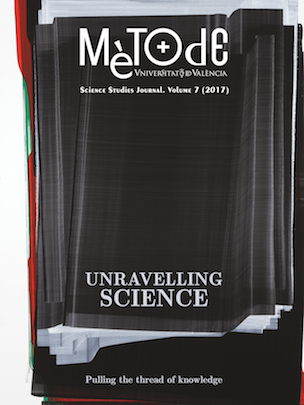Astronomy and space on the big screen: How accurately has cinema portrayed space travel and other astrophysical concepts?
DOI:
https://doi.org/10.7203/metode.7.8530Palabras clave:
astronomy, cinema and science fiction, space travel, asteroids, black holes Resumen
Resumen
Since its origins, cinema has been fascinated with the subject of scientific developments. In particular, astronomy and astrophysics have played an important role in science fiction stories about space travel and exploration. Though the science has not always been accurately represented, in the last decades there has been more and more interest from the cinema industry in approaching scientists to make sure that the stories and concepts shown in films are closer to our true understanding of the universe. In this article, I will explore how cinema has portrayed astrophysical concepts throughout the decades, and how sometimes cinema has even inspired the direction of scientific research.
 Descargas
Descargas
 Citas
Citas
Alcubierre, M. (1994). The warp drive: Hyperfast travel within general relativity. Classical Quantum Gravity, 11, L73–L77. doi: 10.1088/0264-9381/11/5/001
Alvarez, L. W., Alvarez W., Asaro, S., & Michel, H. V. (1980). Extraterrestrial cause for the Cretaceous-Tertiary extinction. Science, 208, 1095–1108. doi: 10.1126/science.208.4448.1095
Campbell, B., Walker, G. A. H., & Yang, S. (1988). A search for sub-stellar companions to Solar-type stars. Astronomical Journal, 331, 902–921. doi: 10.1086/166608
Einstein, A., & Rosen, N. (1935). The particle problem in the general theory of relativity. Physical Review, 48, 73–77. doi: 10.1103/PhysRev.48.73
Hawking, S. W. (1974). Black hole explosions. Nature, 248, 30–31. doi: 10.1038/248030a0
Kostov, V. B., Orosz, J. A., Welsh, W. F., Doyle, L. R., Fabrycky, D. C., Haghighipour, N., ... Borucki, W. J. (2016). Kepler-1647b: The largest and longest-period Kepler transiting circumbinary planet. The Astrophysical Journal, 827 (86). doi: 10.3847/0004-637X/827/1/86
Krauss, L. M. (1995). The physics of Star Trek. New York: Basic Books.
Lovell, J., & Kluger, J. (1994). Lost Moon: The perilous voyage of Apollo 13. Boston: Houghton Mifflin.
Moreno Lupiáñez, M., & José Pont, J. (1999). De King Kong a Einstein: La física en la ciencia ficción. Barcelona: Ediciones UPC.
Morris, M. S., & Thorne, K. S. (1988). Wormholes in spacetime and their use for interstellar travel: A tool for teaching general relativity. American Journal of Physics, 56 (5), 395–412. doi: 10.1119/1.15620
Perkowitz, S. (2007). Hollywood science: Movies, science and the end of the world. New York: Columbia University Press.
Sagan, C. (1985). Contact. New York: Simon and Schuster.
Thorne, K. S. (2014). The science of Interstellar. New York: W. W. Norton & Company.
Weir, A. (2014). The Martian. New York: Broadway Books.
Descargas
Publicado
Cómo citar
-
Resumen2403
-
PDF 920
Número
Sección
Licencia
![]()
Todos los documentos incluidos en OJS son de acceso libre y propiedad de sus autores.
Los autores que publican en esta revista están de acuerdo con los siguientes términos:
- Los autores conservan los derechos de autor y garantizan a Metode Science Studies Journal el derecho a la primera publicación del trabajo, licenciado bajo una licencia de Creative Commons Reconocimiento-NoComercial-SinObraDerivada 4.0 Internacional, que permite a otros compartir el trabajo con un reconocimiento de la autoría del trabajo y citando la publicación inicial en esta revista.
- Se permite y se anima a los autores a difundir sus trabajos electrónicamente a través de páginas personales e institucionales (repositorios institucionales, páginas web personales o perfiles a redes profesionales o académicas) una vez publicado el trabajo.





